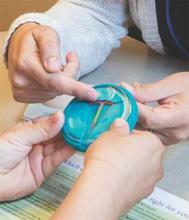About half of pregnancies in the United States are unintentional – an “unacceptably high” rate that underscores the need for ob.gyns. to help improve access to contraceptive implants and intrauterine devices, according to an updated committee opinion from the American College of Obstetricians and Gynecologists.
Physicians should “consider most women good candidates for [long-acting reversible contraception], including teens and nulliparous women,” said Dr. Eve Espey, who chaired ACOG’s working group on long-acting reversible contraception (LARC).
Clinicians also should promote same-day insertion protocols; offer LARC after abortion, miscarriage, and immediately postpartum; and routinely offer the copper IUD for emergency contraception, added Dr. Espey, who is chair of the department of obstetrics and gynecology at the University of New Mexico in Albuquerque.
The ACOG guidance emphasizes recent findings from the Contraceptive CHOICE Project, a large observational clinical trial in which LARC was 20 times more effective at preventing unintended pregnancies than oral contraceptive pills, patches, or rings. And other studies have tied the use of LARC to declines in rapid repeat pregnancy among adolescents and repeat abortion among women who have had an induced abortion, according to ACOG (Obstet Gynecol. 2015;126:e44–8.).
The updated ACOG opinion recommends that ob.gyns. adopt best practices for LARC insertion, including:
• Ensuring that women who request LARC receive it the same day whenever possible, as long as pregnancy can reasonably be ruled out.
• Offering LARC at the time of delivery, abortion, or dilation and curettage for miscarriage.
• Screening for sexually transmitted infections at the time of IUD insertion and treating without removing the IUD.
• Offering the copper IUD as the most effective form of emergency contraception.
The contraceptive mandate under the Affordable Care Act requires that most private insurers cover contraception methods approved by the Food and Drug Administration, including LARC, without copayments or deductibles, Dr. Espey said. But coverage of immediately postpartum IUD insertion is still in the works, with advocates focused on expanding coverage under Medicaid.
“For the time being, Medicaid in only 12 to 15 states reimburses or will soon reimburse for postpartum LARC,” Dr. Espey said. “Busy ob.gyns. can contact ACOG to find out if they live in such a state, and can be a champion to get their hospital on board for offering that service.”
The five LARC devices that are currently available in the United States include four IUDs and a single-rod etonogestrel implant that is approved for up to 3 years of use, according to ACOG. The copper T380A IUD is approved for up to 10 years of use, while two of the levonorgestrel-releasing intrauterine systems can be used for up to 3 years and one can be used for up to 5 years.



